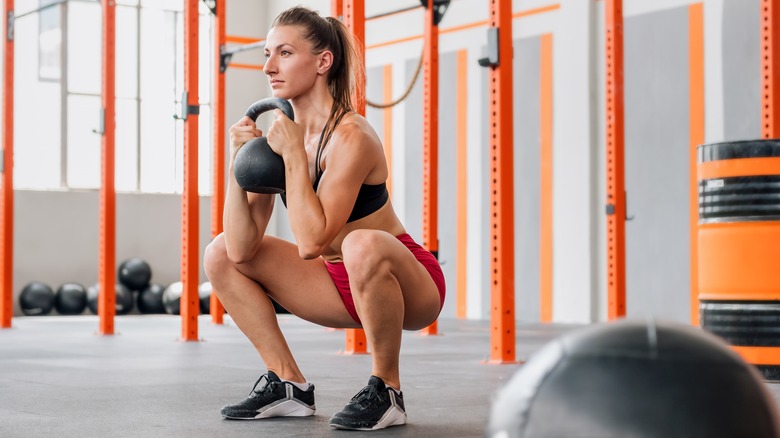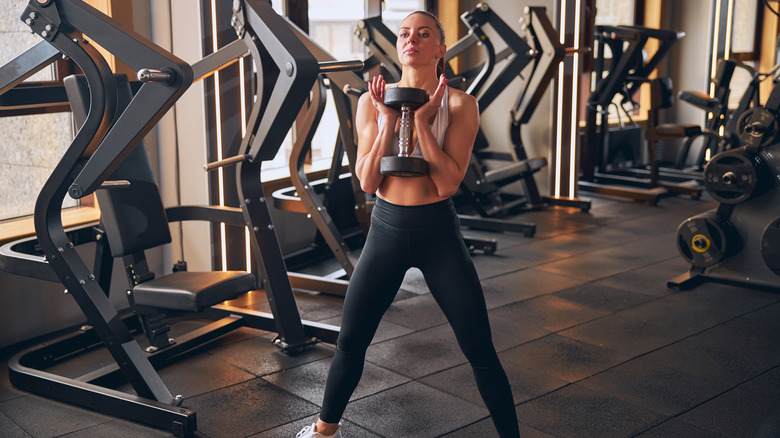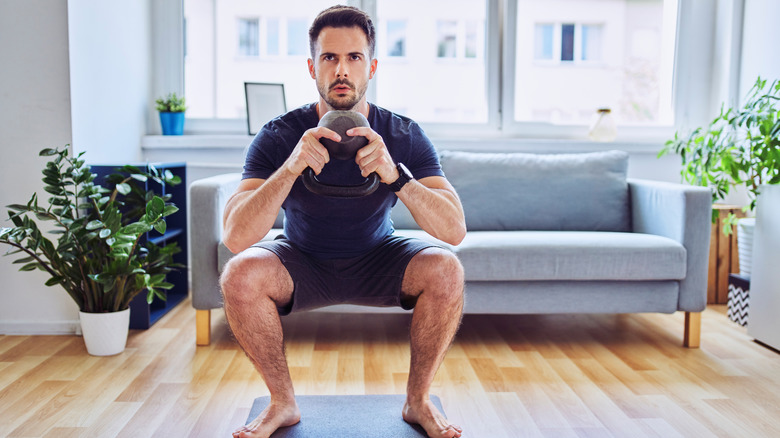How To Do A Goblet Squat With Perfect Form
Squats are a key exercise in any weight training program. You'll see powerlifters, bodybuilders, and powerbuilders do them, but squats help keep your quality of life as you age (via LiveScience). Think about it — how often do you stand up and sit down each day? You're using the same muscles you work in a squat. Squats require you to recruit all the major muscles in the lower body rather than isolate single muscles. Squats also keep your bones and joints healthy. The joints in your hips, knees, and ankles must work together in a closed kinetic chain, which can improve mobility in these joints.
Although the back squat is the most common, trying different types of squats will add a variety to your workouts, according to a 2012 article in the Strength and Conditioning Journal. Goblet squats can recruit force on the muscles of the quadriceps, hamstrings, and back (as per MedicineNet). The wider stance in the goblet squat activates more of the gluteal muscles, and it can be a safer option for people who have knee injuries because it puts less compression on the knee joint, as per the 2012 article. Goblet squats are also a better option for those who have back issues because the weight is on the front of the body (via MedicineNet).
Find the right stance in your goblet squat
The goblet squat can strengthen and stretch your gluteal muscles if you squat deep enough with good form, according to the National Academy of Sports Medicine (NASM). The kettlebell acts as a counterweight as you draw your hips back in a goblet squat, which can increase your range of motion in your glutes. Even if you don't have a kettlebell, hold a dumbbell vertically or use a medicine ball.
Whatever weight you choose, hold it at chest height and close to your body. The width of your feet is your preference, but your foot position will change according to the width of your feet. If your feet are hip or shoulder width apart, your toes should point directly ahead. If your feet are further than hip-width apart, your feet will turn slightly out (via Men's Health). While holding the kettlebell, pinch your shoulder blades together (per NASM). Keep your head straight by keeping your ears on the same plane as your shoulders.
Get the right range of motion in your goblet squat
As you start to drop into your squat, tilt the top of the pelvis back slightly so you don't arch your back too much (via NASM). You'll want to keep your back somewhat neutral, particularly as you execute the movement. Draw your hips behind you as you bend your knees. Your chest shouldn't lean too far forward, so engage your core to keep the weight towards the center of your body. As soon as your back begins to round, it's time to come back up. Drive through your feet and let your glutes help you back to your standing position. If you want to add some spice to your goblet squat, try holding your squat position on the first repetition (per Men's Health). During the second rep, hold for two seconds, then continue adding another second for each repetition in your set.
Some common mistakes to avoid when squatting include rising onto your toes while you lift back to standing, according to the 2012 article in the Strength and Conditioning Journal. Although it might give you a great burn in your calves, you could easily lose your balance. To keep your movement safe for your knees, avoid lifting your heels off the ground while you lower into the squat. Caving your knees inward can also stress your knees, so keep them in line with your shoelaces (via NASM).



